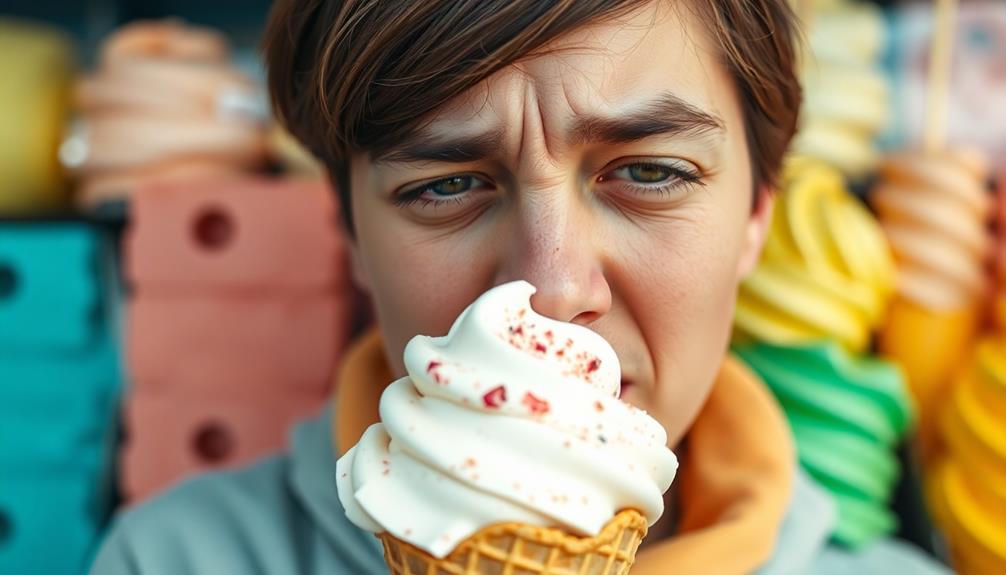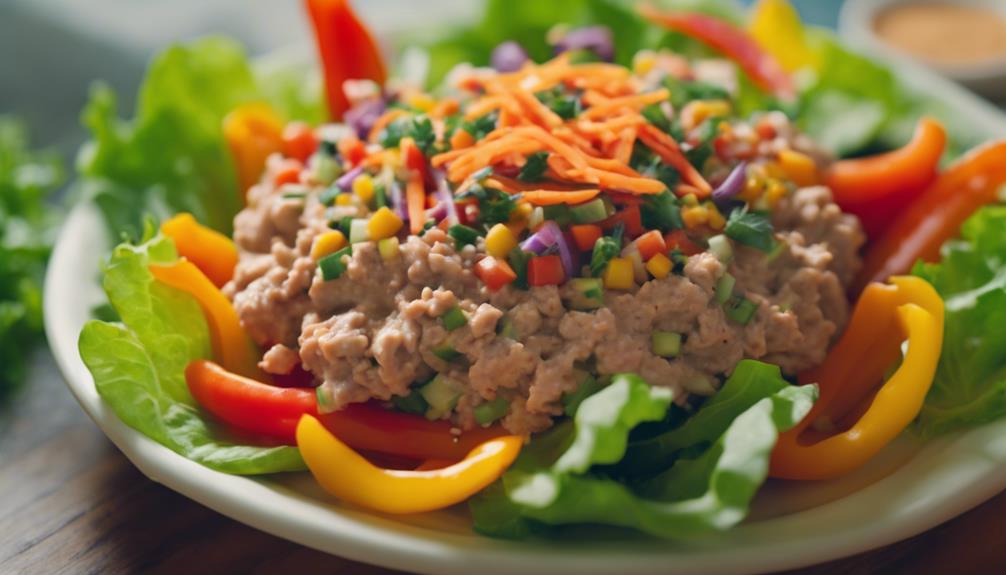Certain cold foods cause brain freeze because they quickly cool the roof of your mouth, activating your trigeminal nerve. This nerve sends pain signals to your brain, interpreting the cooling as distress. You'll typically feel the pain concentrated in your forehead or temples, lasting from a few seconds to about two minutes. Ice cream and slushies are common triggers, especially on hot days when you're eating them rapidly. To avoid discomfort, try eating these treats slowly. There's more to uncover about how to enjoy cold foods without the pain, so stick around!
Key Takeaways
- Brain freeze occurs due to rapid consumption of cold foods, triggering the trigeminal nerve in response to cold exposure.
- Symptoms include sharp pain in the forehead or temples, lasting from a few seconds to two minutes.
- Common triggers for brain freeze include ice cream, slushies, and other cold dishes consumed quickly, especially on hot days.
- The pain results from blood vessel responses; initial constriction followed by dilation leads the brain to interpret temperature changes as distress signals.
- Preventive measures include consuming cold items slowly, pressing the tongue against the roof of the mouth, and having warm beverages handy for relief.
Definition of Brain Freeze

Brain freeze, or sphenopalatine ganglioneuralgia, is that sudden headache you get when you gulp down something cold too quickly. This sharp pain usually hits you in the forehead or temples and can last anywhere from a few seconds to a minute. You might experience it most often while enjoying ice cream or a frozen drink, especially if you're indulging rapidly.
Curiously, enjoying certain cold dishes, like Sichuan Cold Noodles, can also lead to this discomfort, especially during hot summer months when they're particularly invigorating.
What causes this intense discomfort? When cold foods or beverages touch the roof of your mouth, they rapidly cool the palate. This cooling triggers a reaction in your blood vessels, causing them to constrict and then dilate. As a result, the trigeminal nerve, responsible for facial sensations, gets activated, leading to that dreaded headache.
While brain freeze can be quite painful, it's important to remember that it's not harmful. It's actually a temporary protective response from your body, helping to regulate temperature changes in your head.
Curiously, while anyone can experience brain freeze, kids tend to be more prone to it, often because they devour cold treats with little restraint. Those with a history of migraines may also find themselves more susceptible to this phenomenon.
Mechanism of Pain
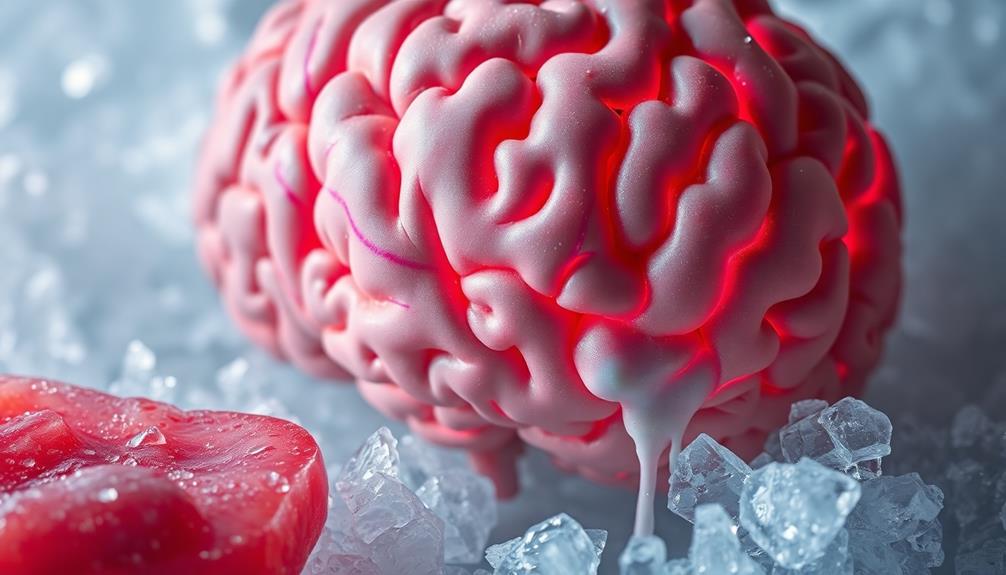
When you indulge in something cold too quickly, the mechanism behind the pain can be quite fascinating. This sudden chill, like biting into ice, triggers a series of reactions in your mouth and brain. For instance, the experience of enjoying a rejuvenating Japanese dish like Zaru Soba can be delightful but might also lead to brain freeze if consumed too rapidly.
Here's how it unfolds:
- Cold Exposure: When ice-cold foods touch the roof of your mouth, they cause rapid cooling of the palate.
- Nerve Activation: The trigeminal nerve, responsible for sensation in your face, gets activated, sending pain signals to your brain.
- Vessel Response: Initially, blood vessels in your mouth constrict due to the cold. This is quickly followed by dilation of the brain's arteries, which leads to intense pain.
- Pain Duration: This cold-stimulus headache typically lasts a few seconds to a minute as your brain interprets the abrupt changes in blood flow as a distress signal.
The intensity of the pain you feel is directly related to how quickly the cold stimulus hits.
Common Triggers
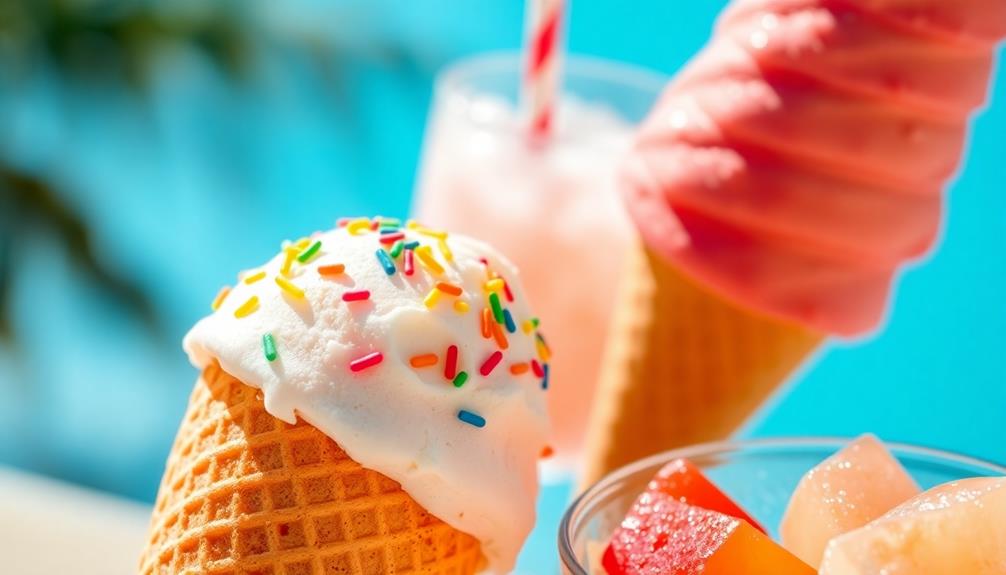
Cold treats like ice cream and slushies are common culprits behind that sharp, fleeting pain known as brain freeze. These icy delights can be especially tempting during festive occasions, such as Halloween, when people enjoy spooky snacks like Graveyard Taco Dip and other themed treats.
When you consume these cold foods rapidly, they chill the roof of your mouth, triggering sensitive nerves in the process. This sudden temperature drop can lead to what many refer to as an ice cream headache, a form of cold stimulus headache.
You're more likely to experience brain freeze if you indulge in these frozen delights on a hot day, as the temptation to eat them quickly increases. The extreme cold of these treats is particularly problematic, especially when you don't give your mouth enough time to adjust.
If you have a history of migraines, you should be cautious; your nervous system may already be highly responsive to temperature changes, making you more susceptible to this sharp discomfort.
Symptoms and Duration
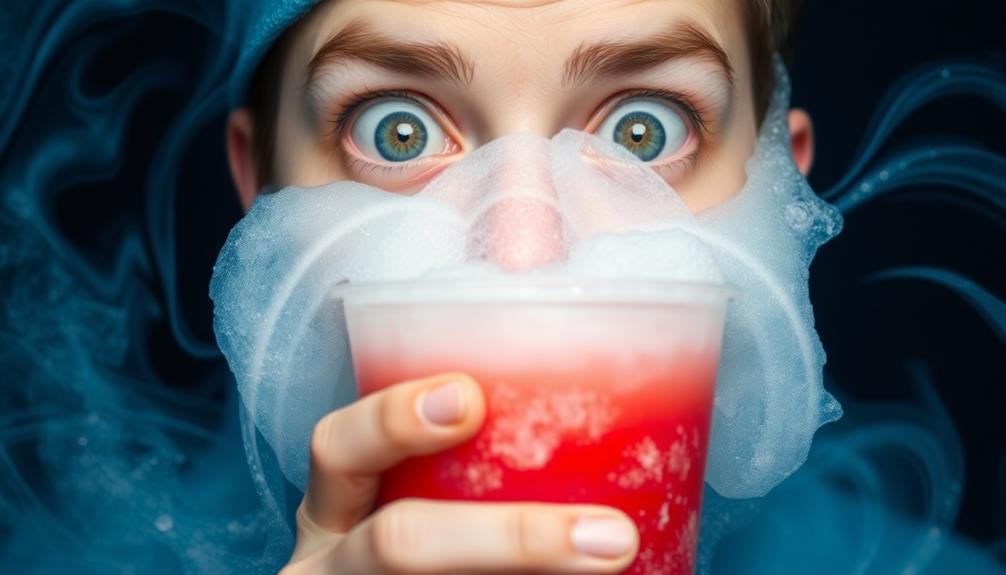
Experiencing that sharp, fleeting pain in your forehead or temples can be startling. This dreaded brain freeze typically strikes when you consume cold items too quickly, like ice cream or slushies, and can even happen with cold beverages enjoyed at your favorite American diner, where classic diner fare might tempt you to indulge quickly.
The intense pain usually lasts from a few seconds up to two minutes, but it can feel much longer when you're in the moment. Unlike other headaches, brain freeze doesn't come with additional symptoms like nausea or light sensitivity, making it quite distinct.
Here are some key aspects of brain freeze:
- Pain Location: The pain is concentrated in your forehead or temples.
- Duration: It lasts from a few seconds to around two minutes.
- Trigger Mechanism: The pain is triggered by the trigeminal nerve responding to cold exposure.
- Self-limiting: It resolves on its own without the need for medication.
Prevention Techniques

To prevent brain freeze, you can start by consuming cold foods and drinks slowly, giving your body time to adjust.
For instance, enjoying a invigorating cranberry punch during gatherings can help you savor the flavors without rushing.
Keeping a warm drink nearby can help soothe any discomfort if brain freeze strikes.
Additionally, pressing your tongue against the roof of your mouth can provide quick relief, making your next chilly treat more enjoyable.
Slow Consumption Method
One effective way to prevent brain freeze is by consuming cold foods and beverages slowly. This method allows your body's temperature regulation mechanisms to adjust, reducing the likelihood of triggering that painful sensation.
By practicing slow consumption, you can help warm the cold substance in your mouth before swallowing, minimizing the impact on sensitive nerves. Additionally, enjoying seasonal dishes like a Grilled Peach and Burrata Salad during summer can provide a revitalizing experience without the risk of discomfort.
Here are some tips for slow consumption:
- Take smaller bites or sips: This helps warm the cold item before it hits your throat, reducing temperature changes.
- Hold cold items in your mouth briefly: This allows your mouth to adapt gradually, lessening the shock to your system.
- Be mindful of your speed: Especially during hot weather, slow down your enjoyment of cold treats to avoid sudden discomfort.
- Allow blood vessels to adjust: Gradual consumption helps warm blood circulate, preventing rapid vasodilation that can lead to brain freeze.
Warm Water Relief
Sometimes, a simple solution can be the most effective when it comes to preventing brain freeze. Drinking warm water right after indulging in something cold can provide immediate relief. The warmth helps to restore the temperature of the roof of your mouth, counteracting the cold stimulus that triggers the pain.
Here's a quick reference table to help you understand how to alleviate brain freeze:
| Technique | Description |
|---|---|
| Warm Water | Sip warm water immediately after brain freeze. |
| Drinking Warm Liquids | Keep warm beverages handy while enjoying cold foods. |
| Covering Mouth & Nose | Breathe in warm air to warm the palate. |
| Sipping Slowly | Take smaller sips to minimize cold exposure. |
| Pressing Tongue | Press your tongue against the roof for warmth. |
Tongue Press Technique
Often overlooked, the tongue press technique is a quick and effective way to prevent brain freeze. This simple maneuver can save you from discomfort when enjoying cold treats. By pressing your tongue against the roof of your mouth, you can help warm the sensitive palate, counteracting the cold stimulus that triggers brain freeze.
Curiously, just as certain traditional Angolan dishes are rich in flavor and comfort, this technique brings a similar sense of relief during summertime indulgences.
Here's how to do it:
- Feel the Onset: As soon as you sense brain freeze, act quickly.
- Press Your Tongue: Firmly place your tongue against the roof of your mouth.
- Hold It There: Maintain the pressure for about 10 to 30 seconds.
- Breathe Calmly: Focus on your breathing to help relax your body.
This technique is particularly useful in hot weather or during summer months when you're likely to indulge in cold foods or drinks.
Following this method can shorten the duration of discomfort and is a practical solution without the need for any medical advice.
Next time you're about to enjoy something chilly, remember the power of your tongue to keep brain freeze at bay!
Treatment and Relief

When brain freeze strikes, quick warming techniques can bring you relief. You can press your tongue against the roof of your mouth or drink warm water to ease the pain.
To make your gatherings even more enjoyable, consider serving fun Halloween-themed snacks like Graveyard Taco Dip or Candy Corn Fruit Parfaits that everyone will love.
To prevent future episodes, remember to consume cold treats slowly and remove the cold source immediately if discomfort hits.
Warming Techniques for Relief
Experiencing brain freeze can be a jarring moment, but there are effective warming techniques that can bring quick relief. When that sharp pain hits, try these simple methods to alleviate discomfort: Enjoying cold treats, like bulgogi, can sometimes lead to this uncomfortable sensation, but knowing how to manage it can enhance your culinary experience.
- Drink something warm: Sipping on warm water can gradually warm the roof of your mouth, easing the cold stimulus that triggered the pain.
- Press your tongue to the roof: By placing your tongue against the roof of your mouth, you can generate warmth and provide faster relief from the intense sensation.
- Cover your mouth and nose: Breathing rapidly while covering your mouth and nose can circulate warm air to your palate, helping counteract the freezing air that caused the brain freeze.
- Have a warm drink ready: Keeping a warm or room-temperature drink nearby while eating something cold can serve as an immediate remedy if brain freeze strikes.
Awareness of these warming techniques can transform your experience of enjoying cold treats, minimizing the discomfort associated with brain freeze and letting you savor every bite.
Prevention Strategies to Avoid
To avoid the discomfort of brain freeze altogether, it's important to adopt a few simple prevention strategies. First, when you consume cold foods and drinks, do so slowly. This helps your mouth adjust to the temperature change, greatly reducing your chances of experiencing that sudden pain. Keep a warm drink on hand; sipping it during or after enjoying cold items can provide quick relief if brain freeze hits.
Here's a quick reference table to visualize these strategies:
| Strategy | Description | Benefit |
|---|---|---|
| Slow Consumption | Eat or drink cold items gradually | Helps mouth adjust to cold |
| Warm Drink | Sip a warm beverage while consuming cold | Alleviates symptoms quickly |
| Tongue Placement | Press your tongue against the roof of your mouth | Warms the area for relief |
Lastly, be mindful of your symptoms and triggers. By following these tips, you can effectively prevent brain freeze and enjoy your favorite cold treats without worry!
Demographics and Susceptibility

Brain freeze can hit anyone, but children often face it more frequently because they tend to gulp down cold treats without a second thought. This rapid consumption of ice cream or slushies increases their susceptibility to brain freeze.
Additionally, much like how enjoying Brazilian desserts can be a delightful experience, rushing through cold treats can lead to that sudden headache. However, age isn't the only factor at play.
Here's a quick breakdown of who's more likely to experience brain freeze:
- Children: Their enthusiasm to enjoy cold foods means they often overlook the consequences.
- Migraine Sufferers: If you have a history of migraines, you might find that cold foods trigger brain freeze more easily.
- Hot Weather: During the summer months, when frozen treats are more popular, the likelihood of brain freeze increases for everyone.
- No Demographic Limitations: Brain freeze can affect individuals of all ages and backgrounds, so it's not just kids and migraine sufferers who need to be cautious.
Awareness of brain freeze symptoms can help you and your children adopt preventive measures when enjoying cold foods.
Frequently Asked Questions
Why Am I so Sensitive to Brain Freeze?
You're more sensitive to brain freeze due to the proximity of sensitive nerves in your palate. Rapidly consuming cold foods triggers an intense nerve response, making you feel the effects more acutely than others.
Why Do You Get a Brain Freeze When You Eat or Drink Something Really Cold?
You're enjoying a cold treat when suddenly—bam!—pain shoots through your head. That's brain freeze, caused by rapid temperature changes cooling your palate, triggering a nerve reaction that sends intense signals straight to your forehead.
Why Are Some People More Prone to Brain Freeze?
You're more prone to brain freeze if you eat cold treats quickly, have a sensitive palate, or experience migraines. Genetics and the speed of consumption play significant roles in your susceptibility to this sudden discomfort.
How Do You Eat Cold Without Getting a Brain Freeze?
To eat cold without getting brain freeze, take small bites, let them warm slightly, sip warm beverages, and pause if discomfort hits. You'll enjoy your treats without the sharp sting of sudden cold.
Conclusion
Next time you plunge into a cold treat, remember that brain freeze is your brain's dramatic way of saying "Whoa, slow down!" By understanding how this icy pain strikes, you can savor your favorite foods without the shock. With a few simple prevention techniques, you can dodge the frosty foe and keep the sweetness flowing. So, enjoy your treats, but don't let that brain freeze steal your joy—after all, life's too short for frozen regrets!
